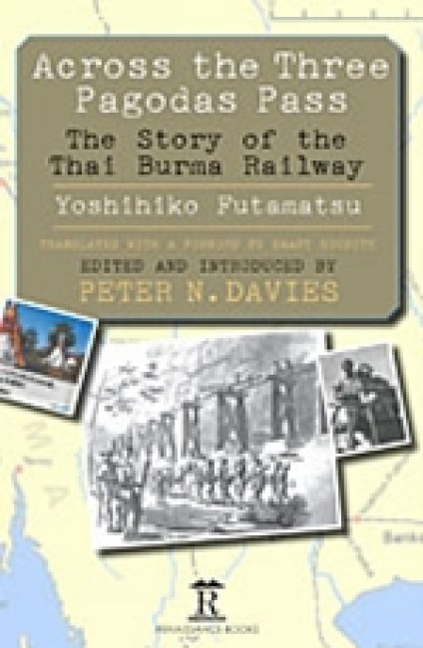Book contents
- Frontmatter
- Dedication
- Contents
- Acknowledgements
- Foreword
- Introduction
- Across the Three Pagodas Pass
- Translator’s Acknowledgements
- Preface
- Chapter 1 Departure for the Front
- Chapter 2 In Indo-China
- Chapter 3 Opening of Hostilities
- Chapter 4 The River Krian
- Chapter 5 The Malayan Campaign
- Chapter 6 The Fall of Singapore
- Chapter 7 Surrender
- Chapter 8 Shōnan: Light of the South
- Chapter 9 The Thai-Burma Railway
- Chapter 10 Preparing Construction
- Chapter 11 Banpong
- Chapter 12 Prisoners-of-War
- Chapter 13 Constructing the Railway
- Chapter 14 Thailand
- Chapter 15 The River Kwae Noi
- Chapter 16 The Mae Khlaung Bridge
- Chapter 17 Kanchanaburi
- Chapter 18 The Jungle
- Chapter 19 From Bangkok to Singapore
- Chapter 20 Rush Construction
- Chapter 21 The Base at Wanyai
- Chapter 22 The Labour Force
- Chapter 23 Survey Unit
- Chapter 24 Test Run
- Chapter 25 Bridge-Building and Shifting Earth
- Chapter 26 The Rainy Season: The Monsoon
- Chapter 27 Kinsaiyok
- Chapter 28 Diseases and Epidemics
- Chapter 29 Cattle Drive
- Chapter 30 Living in the Jungle
- Chapter 31 Soon to the Three Pagodas Pass
- Chapter 32 Towards the Setting Sun
- Chapter 33 Opening to Traffic
- Chapter 34 The Bombing
- Chapter 35 End of the War
- Chapter 36 Internment
- Chapter 37 Repatriation
- Footnote
- Postscript
- End Notes
- Glossary
- Bibliography
- Index
Chapter 2 - In Indo-China
Published online by Cambridge University Press: 13 May 2022
- Frontmatter
- Dedication
- Contents
- Acknowledgements
- Foreword
- Introduction
- Across the Three Pagodas Pass
- Translator’s Acknowledgements
- Preface
- Chapter 1 Departure for the Front
- Chapter 2 In Indo-China
- Chapter 3 Opening of Hostilities
- Chapter 4 The River Krian
- Chapter 5 The Malayan Campaign
- Chapter 6 The Fall of Singapore
- Chapter 7 Surrender
- Chapter 8 Shōnan: Light of the South
- Chapter 9 The Thai-Burma Railway
- Chapter 10 Preparing Construction
- Chapter 11 Banpong
- Chapter 12 Prisoners-of-War
- Chapter 13 Constructing the Railway
- Chapter 14 Thailand
- Chapter 15 The River Kwae Noi
- Chapter 16 The Mae Khlaung Bridge
- Chapter 17 Kanchanaburi
- Chapter 18 The Jungle
- Chapter 19 From Bangkok to Singapore
- Chapter 20 Rush Construction
- Chapter 21 The Base at Wanyai
- Chapter 22 The Labour Force
- Chapter 23 Survey Unit
- Chapter 24 Test Run
- Chapter 25 Bridge-Building and Shifting Earth
- Chapter 26 The Rainy Season: The Monsoon
- Chapter 27 Kinsaiyok
- Chapter 28 Diseases and Epidemics
- Chapter 29 Cattle Drive
- Chapter 30 Living in the Jungle
- Chapter 31 Soon to the Three Pagodas Pass
- Chapter 32 Towards the Setting Sun
- Chapter 33 Opening to Traffic
- Chapter 34 The Bombing
- Chapter 35 End of the War
- Chapter 36 Internment
- Chapter 37 Repatriation
- Footnote
- Postscript
- End Notes
- Glossary
- Bibliography
- Index
Summary
On the anniversary of the Emperor Meiji's birthday, 3 November, we reached the waters off the southern coast islands and the following day entered the port of Haiphong, at that time a French possession in Indo-China (now North Vietnam). It was known as ‘Indo’ for short. Near the ship were cargo-handling lighters (sampans) and a crowd of peddlers’ little boats. Their Annamese dress was new to me and when I heard them talking I realized I had indeed come to a foreign country and for the first time I set foot on foreign soil.
Even at night the heat did not abate. On the lovely lakeside of Granlac the chalkstone buildings were reflected in the quiet waters of the lake. One walked down tree-lined streets and in the French manner cafés lined the sidewalks. There were petits fours cakes which were sweet-tasting, and we enjoyed a helping.
In mid-November we were transferred from Haiphong to towns along the line of the transverse railway called The Phut & Embai Line. The train crossed a high steel bridge over the River Songkoi called Bon de mer. The bridge served two purposes, first as a bridge route: second, when there were no trains it isolated the railtrack which provided unusual facilities. At Embai there was military training every day.
My unit was the first to go to Saigon. On 25 November we entrained at Haiphong station. From the carriage window you could see the South China Sea. Somehow the atmosphere was tense, but one still sensed no indication that one was at war. The train arrived at Saigon on 28 November. Saigon was called the Paris of the Orient, a beautiful town which Frenchmen took to their hearts. On the main street under the rows of trees in Maronie there were cafés and at teatime a band performed a musical programme. The leaves in the line of trees shone through and through in the hot southern sun, trembling and whispering in the breeze. I remember my first taste of snails as the French cooked them.
- Type
- Chapter
- Information
- Across the Three Pagodas PassThe Story of the Thai-Burma Railway, pp. 3 - 5Publisher: Amsterdam University PressPrint publication year: 2013

